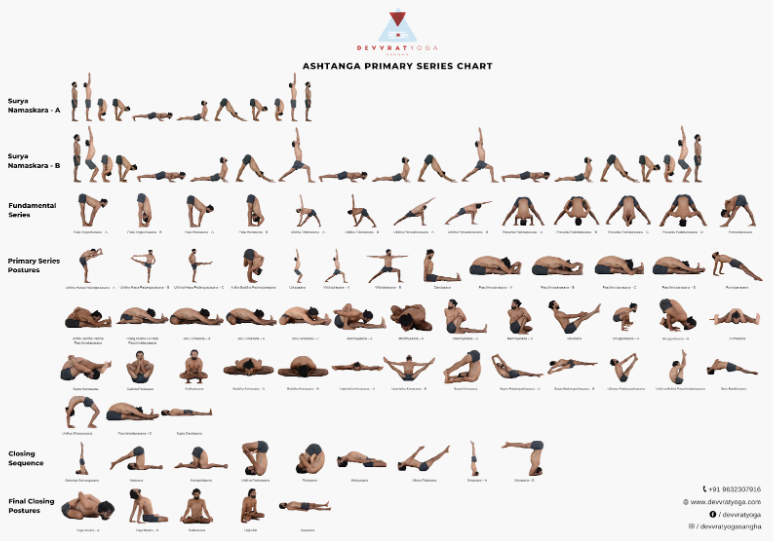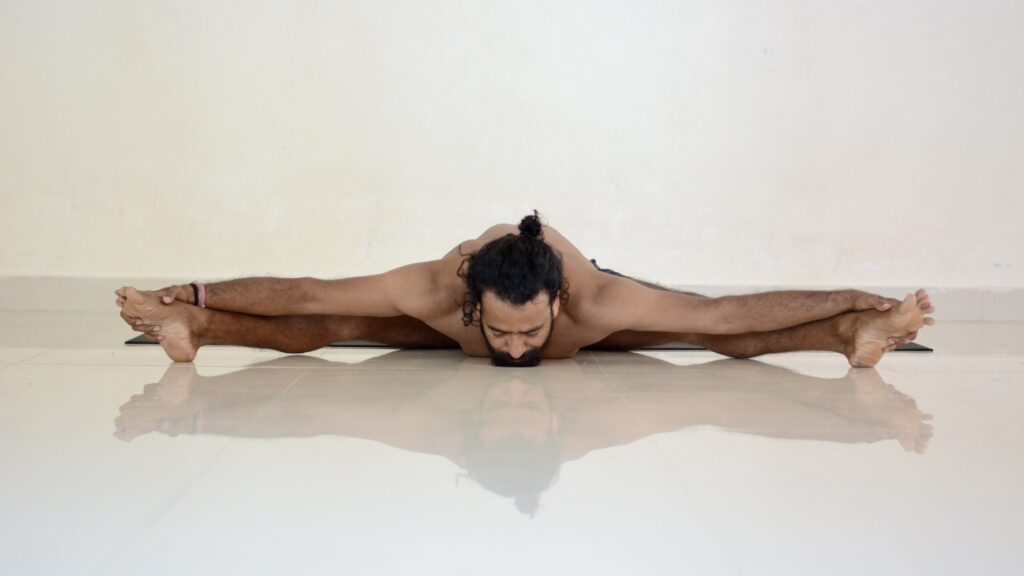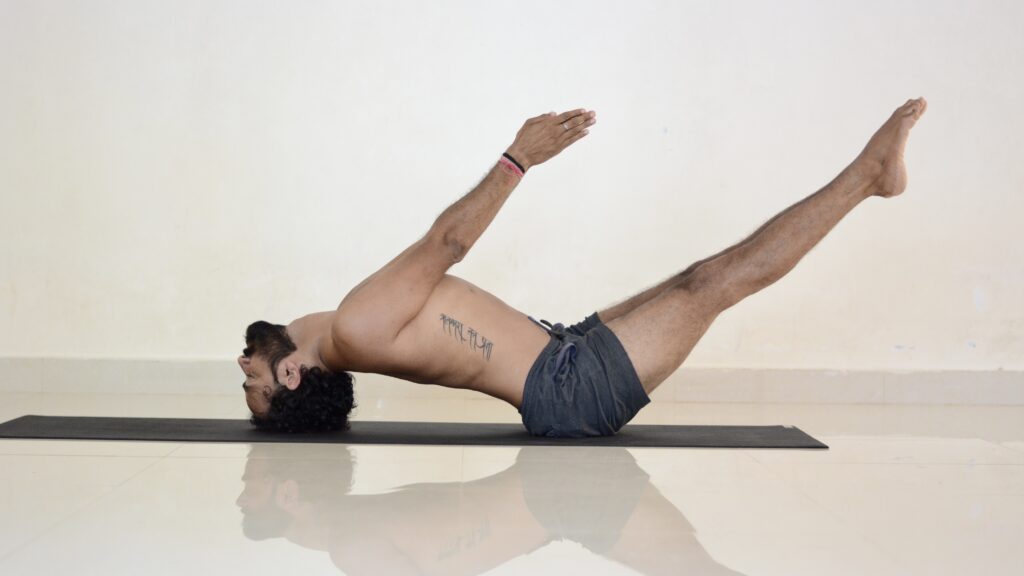What is the history of Ashtanga Vinyasa Yoga?
Ashtanga yoga means the eight limbs of yoga. While yoga has a history of more than 5000 years, Ashtanga yoga was first referenced around ( 500 – 300 ) BC by the great sage Patanjali. He categorized yoga into eight branches, and it is the reason it is known as eight-limbed yoga or Ashtanga Yoga. It is a collection of 196 Sanskrit sutras and is outlined in the Yoga Sutras.
The famous yoga guru, Tirumalai Krishnamacharya, traveled to the distant Himalayas in his quest to learn Ashtanga Yoga from the saint Rama Mohana Brahmachari, who meditated in a cave.
Krishnamacharya spent many years under the great saint’s tutelage, learning about many forms of yoga.
Then the saint told him that the origins of yoga were in an ancient text written on banana leaves kept in a library in Calcutta, and known as the Yoga Korunta book.
In the mid-1920s, Krishnamacharya, along with his young disciple, K. Pattabi Jois, visited the Calcutta Library, where they found the lost yogic text of Yoga Korunta, written by the sage Vamana Rishi.
The detailed palm leaves described the dynamic of the vigorous Hatha Yoga. Krishnamacharya set about understanding the text and taught the methods in it to Jois. It is said that as soon as the duo had learned the way of Ashtanga yoga, the leaves started disintegrating by themselves, and the book was never seen again.
The book described a sequence of intense physical movements connected through breathwork and focussed eye gaze.
Pattabi Jois then devoted his life to teaching this form of yoga and spread it far and wide across the globe. In the 1970s, Jois traveled along with his son to spread awareness of Ashtanga Vinyasa Yoga in the Western world. Many famous personalities like Sting, Madonna, and Gwyneth Paltrow have been his students and proponents of Ashtanga Yoga.
What are the eight limbs of Ashtanga Yoga?
Ashtanga Yoga, as explained by Patanjali, has eight sections or limbs. It is an art of conscious living combined with a spiritual practice that leads one to self-knowledge, freedom, and better physical health.
The eight limbs are as follows:
- Yama – Principles or moral code
- • Ahimsa – nonviolence
- • Satya – truthfulness
- • Asteya – non-stealing
- • Brahmacharya – chastity
- • Aparigraha – non-possessiveness
- Niyama – personal discipline
- • Saucha – purity physical and mental
- • Santosh – contentment
- • Tapa – perseverance
- • Swadhyaya – self-study
- • Eshwar Pranidhan – contemplation of God
- Asana – Asanas are the yogic postures or positions that one can hold for a certain period of time, while at the same time staying relaxed, comfortable, balanced, and motionless.
- Pranayama – Pranayama is yogic breathing. Prana means breath, and Ayama means to lengthen. Thus the word connotes the yoga of breath lengthening.
- Pratyahara – It is a withdrawal of the senses. It teaches one to withdraw within one’s own awareness and to separate the external objects from the internal sensory experiences.
- Dharana – Concentration. It means to introspect, concentrate and focus with single-mindedness on a singular object.
- Dhyan – Means meditation. It reaches to contemplate and reflect with a profound meditation on the abstract.
- Samadhi – Or salvation and unified consciousness. It teaches the science of trance meditation to be in union with and to combine oneself as a harmonious whole with the Universe.
These eight limbs of Ashtanga Yoga were presented in the Yoga Sutras and compiled by the great sage Patanjali around 400 BC.
What are the five characteristics that make Ashtanga Vinyasa Yoga unique?
The foundation of Ashtanga Vinyasa Yoga is the Trishana system. It has three actions that are correlated. They are Asana, Drishti, and the Vinyasa breathing system.
The five characteristics that make Ashtanga Yoga unique are:
Focus on the breath
The breathing technique known as Ujjayi or Victory is the mainstay of Ashtanga Yoga. The inhalation and exhalation are of the same intensity and duration.
Asana or yoga postures
The poses or asanas are performed one after the other in a sequential follow and continuous breathwork throughout.
Vinyasa
One breath is assigned to each movement. Each asana is performed with a set number of breaths or vinyasa. For example, the asana of Ashtanga Surya Namaskar – A has a set of nine Vinyasas. The first starts with inhalation as you raise your arms upwards and join them, then the next is exhalation as you bend forward, and so on.
Bandhas or locks
This characteristic is very unique to Ashtanga Yoga. This practice engages the deep core muscles known as the bandhs or locks. The life force of the energy in our body is Prana, and these valves or locks operate to control its flow throughout our body. Some of the energy regulating lock asanas are, Mul Bandha, Uddiyana Bandha, and Jalandhara Bandha.
Drishti
The last characteristic of the Ashtanga Yoga practice is the practice of Drishti. In this, the gaze is fixed upon a set object or point but in a relaxed manner.
If you practice Ashtanga Yoga regularly and with perseverance, you can purify both your mind and body and benefit from the revelation or union with supreme consciousness.
What are the three levels of Ashtanga Vinyasa Yoga?
The three levels of Ashtanga Vinyasa yoga are conducted in a set of 6 series. They have been described in Yoga Mala by Shri Pattabi Jois.
- • The primary series is known as Yoga Chikitsa, or Yoga Therapy, because of the cleansing effect it has on the body. It starts with Surya Namaskars and moves on to standing, sitting, twisting, backbend poses and inverted poses. It realigns the spine, builds strength, and detoxifies the whole body.
- • The intermediate series is known as the Nadi Shodhana. It cleanses and strengthens the nervous system. It has a series of backbends, headstands, and hip opening poses that open the energy channels of your body. It is taught only after the first series and is more intense. It is recommended to complete this series with a long Shavasana.
- • The advanced series of Ashtanga Vinyasa Yoga has four stages, and they are called the Sthira Bhaga. It means Divine Stability. It requires higher levels of endurance and flexibility and is recommended for advanced students only.

What are the benefits of Ashtanga Vinyasa Yoga?
Ashtanga Vinyasa yoga improves physical strength, balance, muscle tone, flexibility, stamina, and vitality. At the same time, it reduces fat, cholesterol, blood sugar level, stress, and anxiety.
It also improves cardiovascular fitness and reduces blood pressure. Its breathing techniques increase your lung capacity. It brings the hormonal levels of the body into balance and leads you to greater happiness and improved relationships.
The practice of Ashtanga Yoga improves both your mind and body as a whole.
Improve your daily life with Ashtanga Vinyasa yoga.
Ashtanga Vinyasa yoga is a discipline that challenges both your mind and your body. Ashtanga yoga can be customized to suit your individual needs and is hands-on. You can look forward to a high-performing life by practicing this form of yoga because it focuses on improving both your upper body and your lower body strength. It also tones your abdominal muscles.
Ashtanga yoga improves not only your physical strength but also your mental strength, willpower, and vitality.
Interested in becoming a yoga teacher?
Newsletter
Upcoming events and latest blogs

